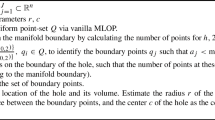Abstract
Inferring underlying manifold of data is one of the important issues for point cloud data analysis. This is accomplished by inferring the topological shape of the underlying manifold. This is done by estimating the number of holes in the underlying manifold in each dimension.
Persistent homology is one of the means of estimating the number of holes in the underlying manifold. Calculating the persistent homology of data determines the size, number, and dimensions of holes produced from data points. However, the number of holes represented through persistent homology is far greater than that in underlying manifold. This problem is caused by noises in a result of calculating persistent homology. Therefore, reducing noises that result from calculating persistent homology is necessary to estimate the number of holes in the underlying manifold.
Conventional methods cannot reduce noises adequately when data are of low density and thus cannot estimate the number of holes in the underlying manifold without manual analysis by experts.
In this study, we propose a new method to estimate automatically the number of holes in the underlying manifolds. We also compare the proposed and conventional methods and show the effectiveness of the former.
Access this chapter
Tax calculation will be finalised at checkout
Purchases are for personal use only
Similar content being viewed by others
References
Futagami, R., Shibuya, T.: A method deciding topological relationship for self-organizing maps by persistent homology analysis. In: Proceedings of SICE Annual Conference 2016, pp. 1064–1069 (2016)
Zomorodian, A., Carlsson, G.: Computing persistent homology. Discret. Comput. Geom. 33(2), 249–274 (2005)
Edelsbrunner, H., Harer, J.: Persistent homology-a survey. Contemp. Math. 453, 257–282 (2008)
Fasy, T.B., Lecci, F., et al.: Confidence sets for persistence diagrams. Annu. Stat. 42(6), 2301–2339 (2014)
Bubenik, P.: Statistical topological data analysis using persistent landscapes. J. Mach. Learn. Res. 16(1), 77–102 (2015)
Gameiro, M., et al.: A topological measurement of protein compressibility. Jpn. J. Ind. Appl. Math. 32(1), 1–17 (2013)
Zhang, W., et al.: An optimized degree strategy for persistent sensor network data distribution. In: Euromicro International Conference on Parallel, Distributed and Network-Based Processing (2012)
Zhu, X.: Persistent homology: an introduction and a new text representation for natural language processing. In: Proceedings of the Twenty-Third International Joint Conference on Artificial Intelligence (2013)
Steiner, D.C., Edelsbrunner, H., Harer, J.: Stability of persistence diagrams. Discret. Comput. Geom. 37(1), 103–120 (2007)
Hastie, T.J., Tibshirani, R.J.: Generalized Additive Models, 1st edn. Chapman & Hall/CRC, Boca Raton (1990)
Nene, S.A., Nayar, S.K., Murase, H.: Columbia object image library (COIL-20). Technical report, No. CUCS-005-96 (1996)
Author information
Authors and Affiliations
Corresponding authors
Editor information
Editors and Affiliations
Rights and permissions
Copyright information
© 2019 Springer Nature Switzerland AG
About this paper
Cite this paper
Futagami, R., Yamada, N., Shibuya, T. (2019). Inferring Underlying Manifold of Data by the Use of Persistent Homology Analysis. In: Marfil, R., Calderón, M., Díaz del Río, F., Real, P., Bandera, A. (eds) Computational Topology in Image Context. CTIC 2019. Lecture Notes in Computer Science(), vol 11382. Springer, Cham. https://doi.org/10.1007/978-3-030-10828-1_4
Download citation
DOI: https://doi.org/10.1007/978-3-030-10828-1_4
Published:
Publisher Name: Springer, Cham
Print ISBN: 978-3-030-10827-4
Online ISBN: 978-3-030-10828-1
eBook Packages: Computer ScienceComputer Science (R0)




